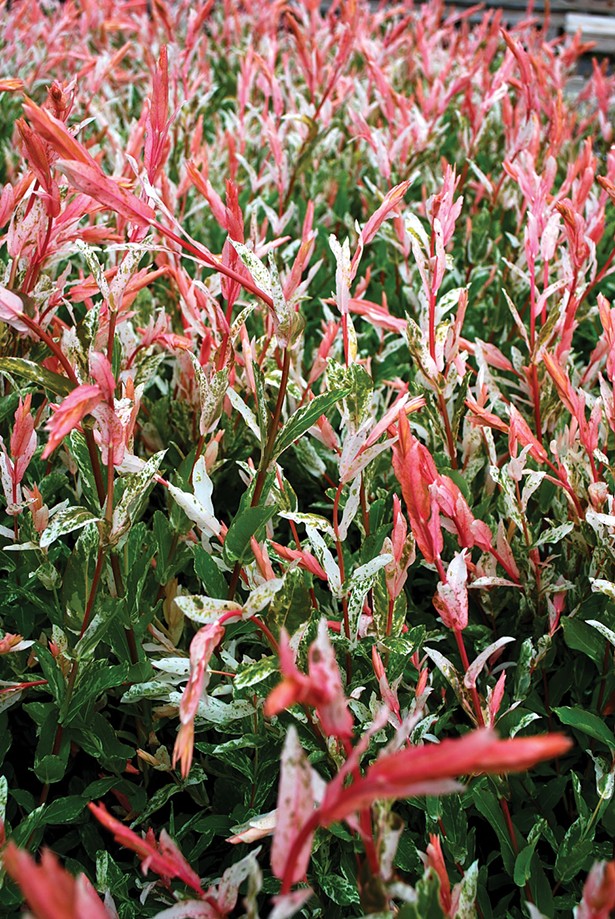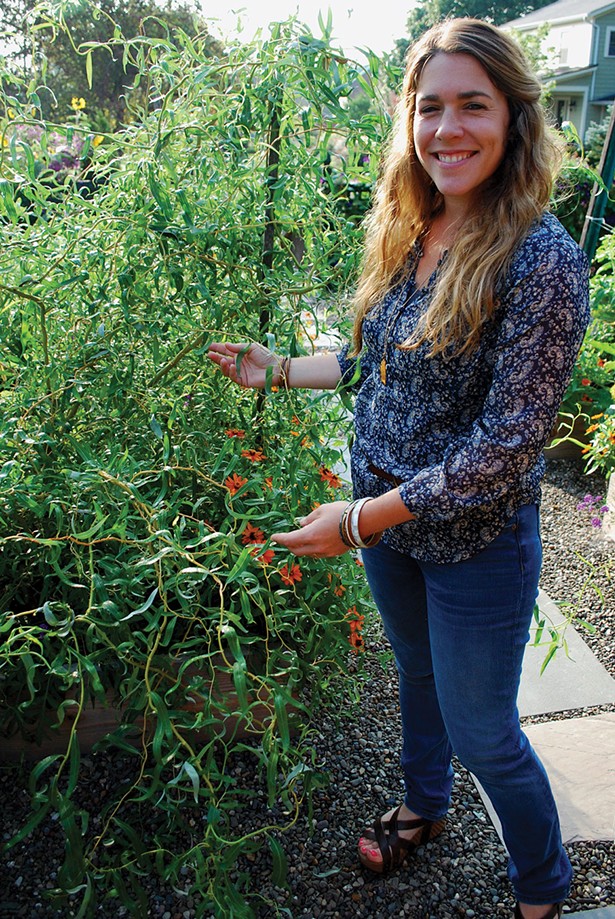Iconic Hot Mess
In the minds of most of us, willows are those trees that weep down by the river. Hudson Valley garden designer, horticulturist, and environmental artist Keith Buesing says he likes weeping willows for their "first-out-the-box spring foliage, their yellow fall color, and their incomparable, grass-skirt hula dance." In winter, observant color-starved folks will note how the weeping willow stems fire up mustard-yellow as early as February.
However, Buesing prefers his weeping willows at a distance because they are weak wooded and tend to constantly drop leaves, twigs, and branches. "They need room to explode into their massive potential [40 to 60 feet tall and wide] and where their ultimate blowing over won't do any damage," he says.
This tendency for weeping willows to topple when overly mature (which happens on average at about 50 years) is related to the fact that the trees grow very quickly (2-3 feet per year). Like that of many other fast-growing trees, weeping willow wood is less dense and therefore weaker. Weeping willow roots are also very canny about finding cracks in sewer and water lines and foundations—and exploiting them. For all these reasons, weeping willows aren't recommended for the average home landscape.
However, there are scores of smaller and equally (or more) ornamental willows that you can use in the home landscape that won't create these hassles. They can be small trees, shrubs, groundcovers, and even tiny alpines.
Non-Problematic Faves
Salix integra 'Hakuro-nishiki' is a willow that's ubiquitous now, for good reason. Its common name is "dappled Japanese willow," and it maxes out at about 12 feet tall. Its young stems turn orange-red in the wintertime. The new foliage in the spring emerges bright salmon-pink, then spends early summer dappled green and white with hints of salmon, then gradually fades to mostly green.
Buesing says, "I've used 'Hakuro-nishiki' as singular accent pieces, but I especially like them as hedges—either straight border hedges or purely sculptural, free-flowing, serpentine hedges in the middle of a green field. They are crazily productive growers—8 to 10 feet a year—which means they'll get to where you want them, quickly. However, diligent, multiple prunings per season are required to keep them full, tight, and the size and shape you want." Pruning is also required to keep the most intense foliage colors coming.
Liz Elkin, owner of Bloom Landscape Design and Fine Gardening, also uses 'Hakuro-nishiki' extensively. "It works beautifully as a privacy screen, capable of growing ahead of deer damage," she says. "It also has the potential to be used for creating a wall of color, a stunning backdrop for a landscape. I have used swaths of this willow for privacy screenings around pools and along property lines with ease and success. It's also fairly inexpensive which is always a plus when adhering to a client's budget."
Like other willows, 'Hakuro-nishiki' prefers wet soils but this particular cultivar is even more adaptable in that it also tolerates dry soils better than other willows. It likes full sun best, but sun in the morning with some afternoon shade can also work and even be appreciated when summers are hot.
Elkin also recommends the 'Flame' willow, so named because in winter, the stems glow a bright orange-red. "It doesn't look like much during the warm growing months," she says, "but then when it drops its leaves for the winter, it magnificently pops, adding much appreciated color to the winter landscape." A colorful mass of 'Flame' stems looks especially striking in front of evergreens. These willows mature at 10 to 12 feet tall.
'Flame' and other colorful-stem willows benefit from a technique called "coppicing." In late winter/early spring, when you coppice a shrub, you cut its stems back hard, nearly to the ground. The regrowth will afford you the brightest possible color. New stems = more colorful stems. Older stems = duller color stems.
"Curly willows (Salix matsudana 'Tortuosa') are garden rock stars with a variety of artistic uses," Elkin says. "The branches are all contorted, and I love how they look in the winter all on their own. I harvest them frequently for accentuating winter planters with whimsical structure and vertical intrigue. Whenever people see curly willow stems, they always comment on how cool they look with that Medusa-hair vibe." She adds that curly willow is resilient and grows back quite well after cutting; aggressive harvesting of its branches does not harm it in any way (see "coppicing" above).
Willows are generally easy to propagate. A few years ago, Elkin took a bucket of 15-inch-long cuttings in water from a dear friend's curly willow tree that had become overgrown and needed to be pruned. "It was amazing," she says. "I stuck the cuttings in the ground—literally just stuck them in the earth—along a drip irrigation line. By the end of the season, all were the size of a shrub at least 3 feet tall and ready to take on the winter. I transplanted them the following spring and now have a full hedgerow of the curly willow that I can take cuttings from every year." Every fall, Elkin cuts those curly, golden yellow stems to use for winter planters.
This Willow for That Purpose
Pussy willow (Salix discolor)—the breaking buds of the males are beloved and very ornamental; you can cut the stems and keep them in a [dry] vase for a long time to enjoy the fuzzy little structures said to resemble the pads on a cat's paw. Willows are dioecious, meaning individual plants have either male or female flower parts. Make sure you are getting a male plant, as the female pussy willows do not furnish the showy breaking buds. Pussy willows are good plants for stabilizing wet areas, and they are popular with nesting birds.
Black pussy willow (Salix gracilistyla 'Melanostachys')—See above but with stunning black breaking buds. Much coveted for flower arrangements.
Creeping silver willow (Salix repens)—a groundcover form of willow (2 feet tall by 5 feet wide) with beautiful, furry, silver-blue leaves. Good deer-resistant plant for groundcover, bank stabilization, rain gardens, and beauty. An even smaller dwarf variety called 'Iona' is available in the trade.
Purple willow (Salix purpurea)—a shrub form available in several different cultivars including 'Nana', which gets only 3 to 5 feet tall. Great for stabilizing wet places and attracting butterflies, has purple stems in winter, and is excellent for basketry and hurdles (rustic, woven low fencing for garden use).
Willows flower very early and most willows provide pollen and nectar for the earliest bees to leave the hive. Check your Hudson Valley nurseries first for willows and if necessary, you can order these beauties online.













